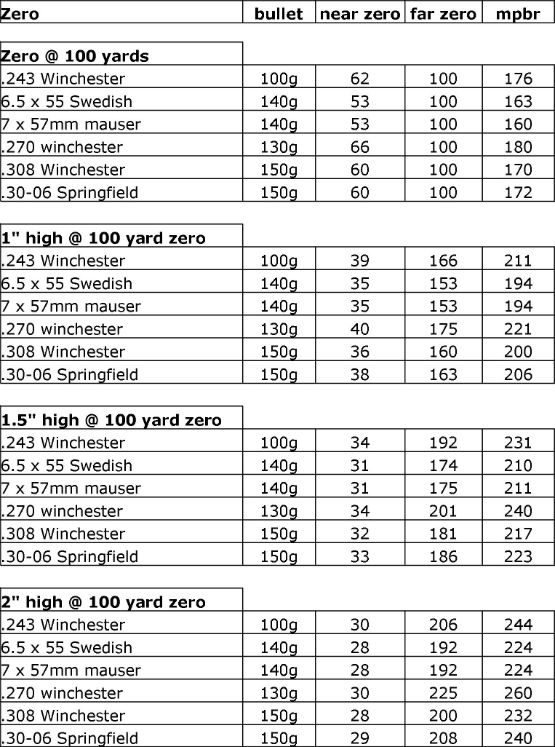Peter Jones considers at what range you should zero your rifle and the meaning of ‘hold over’ and ‘point blank’.
It has recently occurred to me that not one of my clients has ever asked me at what distance our estate rifle is zeroed. Obviously our clients range from absolute beginners to advanced stalkers, but it puzzles me in particular why the more experienced one’s don’t think to ask. It’s the first thing I would want to know!
As many of you know, things can happen very quickly on a stalk and when faced with a rangier shot on a deer and sometimes only seconds to react, that is not the time to debate whether you should aim straight on or hold over x amount!

(The above diagram illustrates the true meaning of 'Point Blank')
I have come to realise, having talked to a good number of my clients, that they take for granted all rifles are zeroed at 100 yards; and there is good reason for people to think this.
When setting the zero on a rifle, the 100 yard zero is pretty much universally accepted as convenient (you don’t have to walk too far to setup, view and retrieve etc.) and accurate enough for shooting at longer ranges.
However, many readers may be surprised to know, that most stalkers don’t leave the zero at 100 yards, they adjust it. This article goes on to explain the reasons why.
Considerations
For the dedicated woodland stalker, a 100 yard zero does the job. Stalking in woodland usually means fairly close shots from 50 – 100 yards. However, stalking within woodland is not for everyone and many prefer to wait until the deer break from the undergrowth and venture out to feed in the open.
Shooting in large open fields or on the hill in Scotland, presents a different challenge. It is much harder to get close to the deer and this in turn requires being able to accurately shoot at greater distances. This is where our discussion turns to holdover and point blank range.
Holdover and Maximum Point blank range (MPBR)?
Definition: Holdover
'Hold over is the adjustment made by the stalker when they are shooting at a range that they are not zeroed for without adjusting the rifle’s scope'.
For example, you have a 100 yard zero and you need to take a shot at 175 yards. If you have determined your bullet will drop say 3inches, you will need to hold over the crosshairs of the reticule 3 inches high to hit your target dead on.
Firstly, to get proficient at shooting accurately at a distance your rifle is not zeroed for, takes a lot of practice. For those starting out, if a longer shot presents itself you have enough to be thinking about without having to employ further considerations.
Maximum Point blank range
For the purpose of this article we will define a deer kill zone as 4 inches. This works for everything from a Munjac to Red stags.
A 4” maximum Point blank range is the furthest distance you can zero your rifle and still insure that your bullet is never 2” higher or 2” lower during its flight than your point of aim. In short this means you can aim dead-on at the target without the need to calculate for bullet drop, or dial in elevation or hold over the target. It is quick and effective.
So what range is best to adjust your zero?
Below are charts compiled to illustrate a range of different popular rifle calibres and the heights to which you might adjust your zero. There are pro’s and con’s for each, as I’ll explain in the following two examples:
(NB: The chart shown below is meant only as a guide, Ballistic Coefficients and muzzle velocities are with standard soft point Federal ammunition. When adjusting your zero from 100 yards, always test your new settings before firing on live quarry)

Maximum point blank zero (2” high at 100 yards)
NB: For the purpose of this article we will use the .243 Calibre as an example.
Pro’s: this affords the shooter the longest range. In the example shown, the .243 user can shoot upto 244 yards
Cons: For experienced shots who may take a neck shot say at 100yards, the bullet will be “2 high making for an inaccurate shot.
100 yard zero
Pro’s: great for woodland stalkers and allows point blank range shooting for the .243 user up to 176 yards.
Con’s: Must use hold over techniques for longer range shots
The best zero for all round deer stalking in the UK
There is no right or wrong answer, but here at County Deer Stalking we have concluded after many hours in the field, that the 1” high at a 100 yard zero is best suited to UK deer stalking.
It suits woodland stalkers as well as highland stalkers. It has a point blank range of 211 yards (.243 calibre) and a far zero of 166 yards.
With the bullet only 1” high at 100 yards I am able to take side on neck shots accurately (which is essential) from close range out to approximately 180 yards which is perfect.
No doubt this article will provoke healthy debate and with the huge variety of calibres in circulation and the differing terrain across the Uk some will disagree with our findings. What is important however is that you discover what works for you and if you are using a borrowed rifle, take a moment to ask the question, when the moment arrives you might be glad you did.
NB: This article discusses shooting at range, this is not for the beginner, who should not attempt to shoot beyond 75-100 yards until they have gained sufficient live stalking experience.
If you are interested in deer stalking a great place to start is by taking the Proficient Deer Stalking certificate Level 1 (PDS1). Find out more here: Proficient Deer Stalking Course - PDS1



















